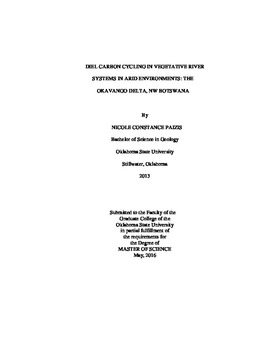| dc.contributor.advisor | Atekwana, Eliot A. | |
| dc.contributor.author | Paizis, Nicole Constance | |
| dc.date.accessioned | 2017-02-22T22:16:00Z | |
| dc.date.available | 2017-02-22T22:16:00Z | |
| dc.date.issued | 2016-05-01 | |
| dc.identifier.uri | https://hdl.handle.net/11244/49130 | |
| dc.description.abstract | We investigate the effects of evapoconcentration, photosynthesis and respiration on diel carbon cycling in densely and non-densely vegetated portions of the Okavango River in semi-arid northwestern Botswana. Previous studies have shown that evapotranspiration has a profound effect on the river water chemistry over seasonal and spatial scales. However, the effect of vegetation induced evapotranspiration in controlling river chemistry and carbon cycling over short term daily cycles is not well understood and has not been previously investigated. We conducted diel investigations in the river channel in the Okavango Delta at two locations that are about 400 km apart. The channel at the proximal end of the delta in Mohembo is located in a permanently flooded wetland ecotone, with a deep channel and is sparsely vegetated, while Maun at the distal end of the delta is located in an occasional flooded wetland ecotone with a shallow channel that is densely vegetated. The physical, chemical and isotopic parameters of river water measured every hour for 24 h showed much higher solute concentrations and more enriched stable isotopic composition of water (?D and ?18O) and stable carbon isotopes of dissolved inorganic carbon (?13CDIC) in the distal portion of the delta due to modification by evapoconcentration and atmospheric interaction during river transit over the 400 km distance. The total dissolved solids (TDS) and silica show diel variations with higher concentrations during the day and lower concentrations at night. The increased solute concentrations during the daytime is attributed to transpiration of aquatic vegetation coupled to evaporation. The pH, alkalinity and ?13CDIC show clear diel trends that were more prominent in the distal portion of the delta at Maun. The controls of carbon cycling during the diel cycle is not dominated by biotic processes, such as, water column photosynthesis, CO2(g) evasion or photo-oxidation during the day and respiration during the night. Our results suggest mostly an abiotic control on solute and carbon cycling, despite the occurrence of extensive vegetation in the river channel, floodplain and adjacent wetlands. We conclude that despite extensive vegetation in the Okavango River, the hydrology and abiotic processes mostly control diel solute and carbon cycling. | |
| dc.format | application/pdf | |
| dc.language | en_US | |
| dc.rights | Copyright is held by the author who has granted the Oklahoma State University Library the non-exclusive right to share this material in its institutional repository. Contact Digital Library Services at lib-dls@okstate.edu or 405-744-9161 for the permission policy on the use, reproduction or distribution of this material. | |
| dc.title | Diel Carbon Cycling in Vegetative River Systems in Arid Environments: The Okavango Delta, Nw Botswana | |
| dc.contributor.committeeMember | Cruse, Anna M | |
| dc.contributor.committeeMember | Quan, Tracy M | |
| osu.filename | Paizis_okstate_0664M_14665.pdf | |
| osu.accesstype | Open Access | |
| dc.description.department | Geology | |
| dc.type.genre | Thesis | |
| dc.type.material | text | |
